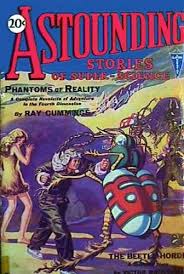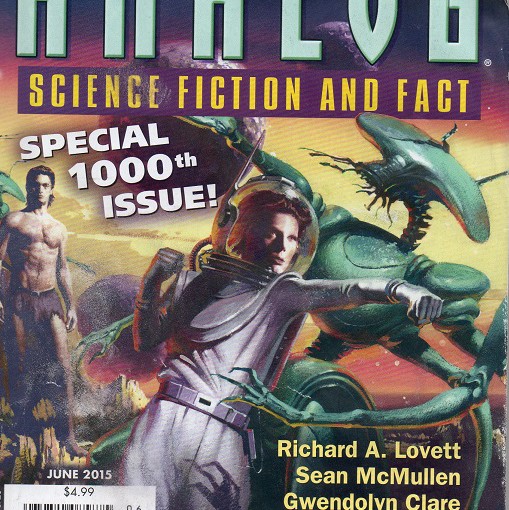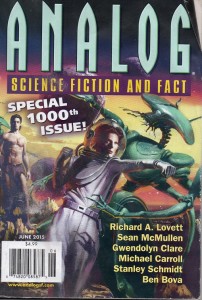Magazine Review: Analog Science Fiction and Fact June 2015 edited by Trevor Quachri
Since its debut issue as Astounding Stories of Super-Science in January 1930, what would become Analog was one of the most influential, and often the most influential, science fiction magazines on the racks. After I reviewed Analog 1 (a collection of stories from when the magazine made its main name change in 1960) last week, I was informed that this month’s issue was in fact the 1000th issue, the longest run of any science fiction magazine and a respectable milestone for any publication. (It has skipped a number of months over the years, or April 2013 would have been the lucky number.)
If the cover by Victoria Green looks a bit odd, it’s because it’s a “remix” of the very first cover (illustrating the story “The Beetle Horde” by Victor Rousseau and painted by H.W. Wessolowski) with the genders reversed. The editorial speaks about that first story (and the issue is available to read at Project Gutenberg!)
Former editors also get to pen a few words. Stanley Schmidt talks about there always being new futures for science fiction writers to write about–no matter how many milestones are passed, there will be more to come. Ben Bova writes of John W. Campbell and his influence on the field of science fiction (generally positive.)
Naturally, there is some fiction in this issue, beginning with “The Wormhole War” by Richard A. Lovett. An attempt to send a wormhole to allow humans to travel to an Earth-like world in a distant star system ends disastrously. Follow-up wormholes end equally badly, but much closer to home. It dawns on the scientists that someone else is making wormholes, and they might not be too happy with us. It’s a serviceable enough story.
“Very Long Conversations” by Gwendolyn Clare features exobiologist Becca and her alien partner Shurza helping with an archaeological dig that is developing some unusual results. Possibly the vanished natives haven’t actually vanished–but then, where are they? This story appears to be part of a series, and refers back to earlier events. (One of the letters to the editor in this issue praises that another series story got a “previously on” section, but this one didn’t.)
“The Kroc War” by Ted Reynolds and William F. Wu is a tale of a human/alien war told in brief reminiscences by the participants. It is a condensed version of many war-related themes, such as the home government not living up to the principles its soldiers are supposedly fighting for, and the ending twist is not surprising if you think about it.
“Strategies for Optimizing Your Mobile Advertising” by Brenta Blevins may be titled like a business blog, but is actually about an artist taking on a strenuous job because their art doesn’t pay well. A crisis arises when his shirt stops working. Amusing.
“The Odds” by Rod Collins is a rare second-person story, with a narrator emphasizing just how unlikely the scenario “you” find yourself in is. It’s short, and describing the plot would give away the twist, so I’ll just say that it’s chilling.
“The Empathy Vaccine” by C.C. Finlay has a misleading title, as one of the characters admits. The protagonist is visiting a doctor to be rid of his capacity for empathy, and doesn’t think through the implications to their logical conclusion. Perhaps it is because his empathy was already too low.
“Flight” by Mack Hassler is a short poem about kinds of flight. It’s okay, I guess. (Long-time readers know modern poetry isn’t my thing.)
“Three Bodies at Mitanni” by Seth Dickinson involves three people who have been assigned to evaluate human colonies sent into space millenia ago to see if they are a threat to humanity, and if so to destroy them. This is their final stop, and perhaps their hardest decision. Is preserving civilization as it exists worth losing the potential that this new direction offers? Disturbing.
“Ships in the Night” by Jay Werkheiser is a tale of a near-first encounter with aliens spun by a spacer to colonists in a local bar. Physicists may catch the twist in the story before the end.
“The Audience” by Sean McMullen rounds out the fiction with a tale of first contact gone horribly wrong. It turns out there’s another planet passing through the Oort cloud, one that’s inhabited. Unfortunately, the aliens aren’t the sort humans are ready to deal with, and it’s up to a storyteller to spin a yarn that will save the day.

One of the things I notice reading this issue as compared to even the 1960 stories in Analog 1 is diversity of protagonists. In the earlier stories, women are love interests and faithful assistants at best, and a non-WASP protagonist is something special that has to be justified. Now, women, people of various ethnicities, and more…unusual protagonists are able to appear with it being “no biggie.”
The fact article is “Really Big Tourism” by Michael Carroll, talking about the possibilities of the Solar System’s gas giants for tourist visits (once we lick the problem of getting there.)
“The Analog Millenium” by Mike Ashley gives us all the statistics we need about the magazine’s 1000 issues. There are a few surprises in here!
The usual departments of letters to the editor, book reviews (mostly psionics-based stories this month) and upcoming events are also present.
This issue is certainly worth picking up as a collector’s item, if nothing else. I liked “The Kroc War” and “The Empathy Vaccine” best of the stories. If you haven’t read science fiction in a long time, you might find the evolution of the genre interesting to consider.



This sounds like an interesting publication, Scott. I had never heard of it before reading review and will consider looking for it as I’m out and about. Thank you for your brief yet complete review of the contents.
Barnes & Nobles has it, if nowhere else.
Scott, I enjoyed reading & writing science fiction in high school but haven’t done either of those things recently! I love this sentence in your review: A crisis arises when his shirt stops working. Makes me smile.
Science fiction is wonderful for interesting phrasing.
Wow, this magazine has been going for a long time and I’ve never even heard of it. How long have you been reading it for?
I was a huge fan of it in the 1970s and early 80s, and have read an issue here and there when I happen to find it. I did get to read many of the 60s issues when I was in college as the Mankato downtown library had a special collection of it. (They also have a very good Laura Ingalls Wilder related collection.)
Congrats to the publishers for hanging in there for so long. Most magazines don’t make it to 1000.
This is the theme of the article that has all the statistics; among other things, it mentions all the magazines Analog has outlasted.
That wormhole story sounds interesting. I wonder if my daughter would like it… thanks for the tip!
You’re welcome!